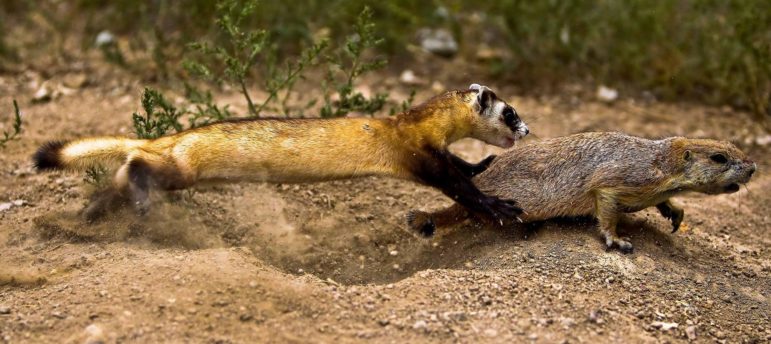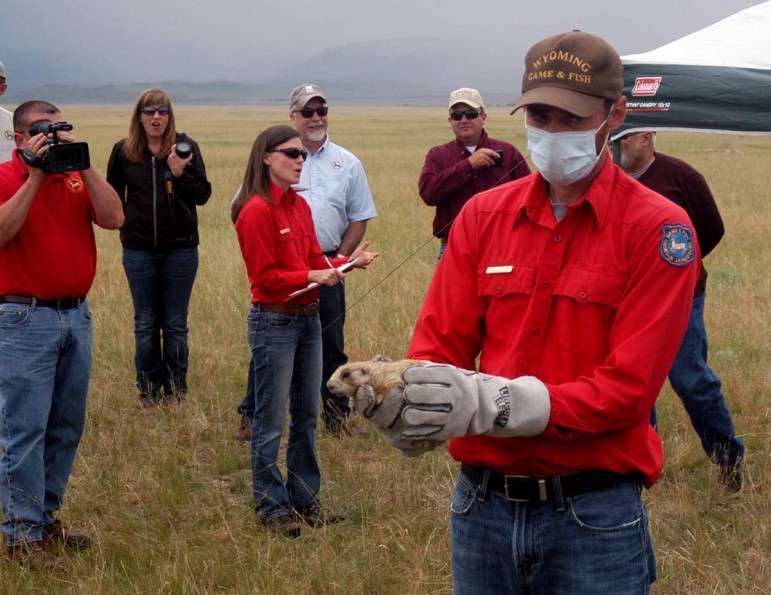
For a couple of hours last week, about three dozen people stood under ominous storm clouds, wandering across a windswept meadow near Meeteetse, Wyo., hoping to catch a glimpse of prairie dogs eating peanut butter.
It wasn’t just peanut butter the wild rodents were ingesting. In fact, the tasty treat was merely the irresistible flavor used in a bait laced with an oral vaccine being tested as a way to control plague among limited populations of wild animals.
And since the gathering of reporters, wildlife officials and researchers was at the Pitchfork Ranch, there was also plenty of discussion about the endangered black-footed ferret.
It was at the Pitchfork that a colony of about 120 black-footed ferrets—the last in the world—was discovered in 1981, long after the animal was thought extinct.
Despite a concerted management effort aimed at saving the species, sylvatic plague and canine distemper swept through the Pitchfork ferrets. By 1986, there were less than 20 black-footed ferrets left alive, with only seven of those capable of breeding.
Plague infects prairie dogs, and can wipe out more than 90 percent of a colony. Black-footed ferrets feed almost exclusively on prairie dogs, and are highly susceptible to plague themselves.
Since 1987, wildlife managers have carried out long-running captive breeding programs that allow for approximately 200 black-footed ferrets to be released each year at 24 reintroduciton sites. Despite the years of work, only a few hundred black-footed ferrets now survive in the wild. Sylvatic plague is present in at least two-thirds of the reintroduction sites.
Which is why Tonie Rocke’s lab smells like peanut butter.
For the past 15 years, Rocke and her colleagues at the University of Wisconsin have been working to develop a plague vaccine for prairie dogs, which could also benefit ferrets and other wildlife. Field testing is ongoing at 29 prairie dog sites across the country, including the Pitchfork Ranch, which Rocke visited for the first time last week.

“Plague is by far the biggest threat to black-footed ferrets,” said Rocke, who works in Madison, Wis. at the U.S. Geological Survey National Wildlife Health Center.
Ferrets can be infected with plague by eating diseased prairie dogs, or by being bitten by fleas carried by prairie dogs.
In Rocke’s lab, the prairie dog vaccine has logged a success rate of 90 percent or higher. After three years of a planned four-year field test, results so far look promising, Rocke said.
But getting to this point hasn’t been easy.
“We have to make all the baits by hand, and I usually have one person making the vaccine and one person making the baits,” Rocke said.
She tested a range of flavors, put peanut butter proved to be the prairie dogs’ favorite. Rocke has now enlisted volunteers to help make the dice-sized bait cubes that are scattered across prairie dog habitat.
Another phase of trials will be needed to figure out how to best distribute the bait, which must be manufactured by automation on a much larger scale if it is to be effective beyond the 40-acre test sites where it is used now.
Impossible to eradicate
It is virtually impossible to eradicate plague from wildlife populations, Rocke said. But government agencies could use the vaccine or variations of it to help protect prairie dogs, black-footed ferrets and other select species in specific areas.
Plague is caused by the bacterium Yersinia pestis, and is transmitted by biting fleas that are common among many species of rodents. Known as sylvatic plague among wildlife, the disease also can infect humans, where it manifests in one of three varieties: the blood-borne septicemic plague; the respiratory infection pneumonic plague; or the lymphatic infection bubonic plague—also known as black death—which killed an estimated 75 million Europeans or more over the course of a single decade in the 1300s.
Cases of plague among humans in the U.S. are exceptionally rare, and can be effectively treated with antibiotics if caught early. Consequently, there is little financial incentive to create a human plague vaccine, although the U.S. Army has developed one that has undergone clinical trials.
Rocke’s vaccine is based in part on earlier work done by the private sector on a plague vaccine for domestic cats, which are highly susceptible to the disease (dogs are relatively resistant). But the company doing that work realized there was insufficient commercial demand, Rocke said, leaving government funding as the only development option.
The biggest obstacle to developing the vaccine has been clearing the complex regulatory hurdles to allow for testing outside the laboratory, Rocke said. The vaccine has proven exceptionally safe across a wide range of wildlife, as well as domestic livestock.
The vaccine uses a modified raccoon poxvirus that produces two proteins of Yersinia pestis, but which does not contain the entire plague bacteria. Ingesting it causes an immune response that produces antibodies that help defend against plague.
The complex and expensive process of creating and disseminating an oral vaccine using millions of bait cubes scattered across countless thousands of acres may seem like altogether too much trouble just to help prairie dogs, or even the endangered black-footed ferrets.
But wildlife managers say the effort is necessary, and can have wide-reaching effects that go far beyond the initial target areas.
A keystone species
“Some say prairie dogs are a keystone species,” said Jesse Boulerice, a Wyoming Game and Fish Department biologist leading the vaccine trial near Meeteetse.
Loss of habitat and plague have removed prairie dogs from an estimated 97 percent of their historic range, Boulerice said. That can mean trouble for other animals that have typically enjoyed symbiotic relationships with prairie dogs, either relying on their burrows, preying on them or reaping the benefits of their proximity. That includes direct beneficiaries like mountain plovers, swift fox and burrowing owls, as well as a wide range of other species that seem to do better with prairie dogs around, including bison, bald eagles and pronghorn.

Ranchers have typically seen prairie dogs as pests because they eat grass and dig holes which can injure cattle. But bison have long coexisted with prairie dogs, and ranchers seem to be growing a bit more tolerant of them, Boulerice said.
“This is not just about prairie dogs or ferrets,” he said. “More and more landowners want to see their land managed on a scale that’s beneficial for wildlife.”
For Lenox Baker, owner of the Pitchfork Ranch, that means moving his cows to different parts of the property, for instance, when lupine wildflowers are present, as they can be toxic to cattle.
“We also want the black-footed ferrets back here,” Baker said. “They were here before, and they were a part of this landscape, so they should be here now.”
Baker may have a chance to be among the first private landowners to host a colony of reintroduced black-footed ferrets, if the U.S. Fish and Wildlife Service approves a rule that would make Wyoming a special management area for the reintroduction of black-footed ferrets under the Endangered Species Act.
The Wyoming Game and Fish Department supports the proposal, which would ease the regulatory constraints of the Endangered Species Act, allowing landowners to voluntarily host reintroduced ferrets. The rule would also protect landowners and neighbors against federal enforcement if any ferrets are accidentally killed on their lands.
Ferrets tend to thrive when they have a sufficient prairie dog prey base that is free of plague, said Kimberly Fraser, with the USFWS National Black-footed Ferret Conservation Center.
They are fierce and prodigious hunters, and routinely take down prairie dogs that are twice their weight.
“They may look cute, but they’ll rip your face off,” Fraser said.
Each ferret will consume an entire prairie dog approximately every three days, meaning that a self-sustaining ferret population will require a prairie dog town that stretches across more than 1,000 acres.
But even when the right habitat can be found, a plague outbreak can spell disaster for both prairie dogs and ferrets within just a few months. Which is why Fraser is bullish on Rocke’s vaccine.
Rocke figures it will take about five years to develop an operational plan for large-scale use of the vaccine in the wild, assuming the current field trials prove successful. Variations of the vaccine could help with a wide range of mammals that are susceptible to plague.
But more importantly, the method used to develop the plague vaccine is likely to prove useful in tackling a wide range of infectious diseases that are killing wildlife across the country, she said.
That includes conditions like white-nose syndrome, a disease carried by a fungus that infects hibernating bats, killing up to 80 percent of affected populations in specific regions across the U.S.
Rocke has spent her entire career working to prevent or reduce wildlife diseases, and said the issue is becoming increasingly more urgent.
Changes in climate and habitat are part of the reason we’re seeing emergent diseases in wildlife, she said, and those trends are only likely to worsen.
“It’s all about protecting these endangered and threatened species,” Rocke said. “If we don’t figure out how to manage these diseases, we’re going to lose our wildlife.”
Contact Ruffin Prevost at 307-213-9818 or [email protected].

I agree peanut butter is highly palatable. One I found a plastic peanut butter jar that a city grey squirrel got out of the recycling bin and chewed a hole in it. Can we regular people help repopulate ferrets? Outdoors in pens? Can crossbreeding with tame ferrets help (?) them or is that disease overpowering. How about rabies? Does it also affect them in the wild? Do prairie dogs carry rabies like raccoons and skunks?
Nancy, thanks for chiming in on peanut butter — a favorite bait for mousetraps at my house in Cody, Wyo.
Other than adding your voice in the appropriate venues for public comment as allowed, I don’t know that there’s a big role for “regular people” (as you put it) to help in repopulating the black-footed ferrets. Breeding them in captivity is still a relatively specialized enterprise, and the federal effort is already calling on a number of facilities, including zoos and other well-equipped partners around the country. Black-footed ferrets are rare enough that I’m fairly certain the biologists would allow kits (young ferrets) or breeding pairs outside their tightly controlled program and into the general public.
Cross-breeding with domestic ferrets would not be a desirable option, because they are two different species, and the breeding program is working to maintain genetic purity and optimum diversity in the small population.
As for rabies, all mammals can contract rabies, but I think it’s relatively rare in ferrets and prairie dogs.
Thanks for reading!
-Ruffin Prevost
As Ruffin explained, it’s pretty difficult for members of the public to help out with captive breeding projects. Although it’s very human to want to get hands-on experience with interesting things, better to leave the wildlife wranglers do their thing and the animals get it on.
I think the best thing that regular people can do to help save BFFs is to stand up for conservation of wildlife areas. They also benefit us humans by being beautiful places to visit and go hiking. And also not letting the government cut funding for scientific research and environmental issues.